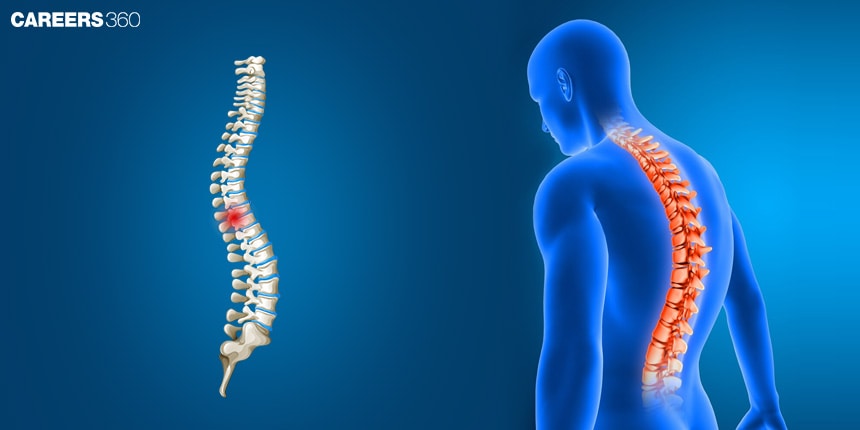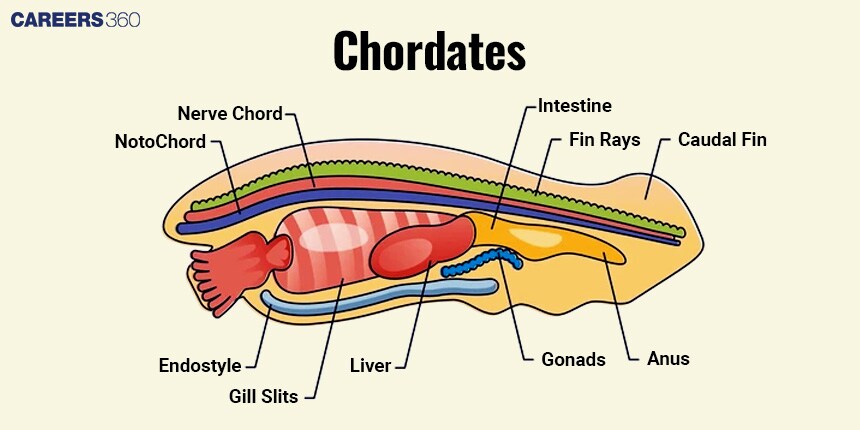Notochord definition: Definition, Types, Structure, Coelomic Cavity, Function
Definition Of Notochord
The notochord is a flexible, rod-shaped structure which constitutes the principal support of the body in all embryonic and some adult chordate animals. It consists of cells derived from mesoderm, the middle layer of embryonic tissue, and is located along the dorsal side of the embryo. It acts as a scaffold for the vertebral column and is crucial for the definition of the primitive axis of the embryo, thereby guiding the proper organisation of the surrounding tissues.
NEET 2025: Mock Test Series | Syllabus | High Scoring Topics | PYQs
NEET Important PYQ's Subject wise: Physics | Chemistry | Biology
New: Meet Careers360 B.Tech/NEET Experts in your City | Book your Seat now
- Definition Of Notochord
- Importance In Vertebrate Development
- Structure Of The Notochord
- Developmental Significance
- Function Of The Notochord
- Evolutionary Perspective
- Clinical Relevance

Importance In Vertebrate Development
In vertebrate development, the notochord is essential because it provides structural support and, in addition, secretes signalling molecules that are crucial for the differentiation and patterning of adjacent structures such as the neural tube and somites. These signals guide the development of the central nervous system and axial skeleton and thus make the notochord a critical player in the embryogenesis of all vertebrates.
Structure Of The Notochord
Knowing the notochord's structure can help in making sense of it in terms of its role in vertebrate development and evolution.
Diagram: Presence Of Notochord In Chordates

Location In The Embryo And Adult Vertebrate
In the embryo, it extends along the dorsal midline from head to tail.
It lies just beneath the neural tube and above the gut.
During embryonic development, it provides the central axis around which the vertebral column forms.
Most of the notochord is replaced by the vertebral column in most adult vertebrates, although remnants are found in humans and other mammals.
Cellular Composition
The notochord core contains large, vacuolated cells sheathed by a network of collagenous fibres and, more superficially, epithelial-like cells.
Such vacuolated cells are rich in glycosaminoglycans responsible for turgor pressure, which helps in the structural integrity of the notochord.
These cells are highly specialised and arise from mesodermal precursors to provide mechanical support at an early stage of development.
Comparative Anatomy Across Vertebrates
The structure and persistence of the notochord vary greatly in vertebrates.
In primitive chordates, the notochord is persistent during life and forms the primary axial support.
In cartilaginous fish, such as sharks, the notochord persists in the adult as a continuous rod running along with the vertebrae.
This is mostly replaced by the vertebral column during development in bony fish, amphibians, reptiles, birds, and mammals.
Developmental Significance
The notochord is central to vertebrate embryonic development: it guides the formation of many structures and lays out the vertebrate body plan.
Formation During Embryogenesis
The notochord is a very early embryonic structure that develops from the mesodermal layer. In particular, it arises from the primitive streak. This happens in human embryos at about the third week—more specifically, cells migrate to form something known as the notochordal process. The mature notochord is differentiated from this, and then it guides the organisation of tissues around it.
Role In The Development Of The Vertebral Column
The notochord is essential for the induction of the mesoderm to form vertebral bodies around it in the development of the vertebral column. In most vertebrates, this notochord gets replaced by the vertebrae and intervertebral discs with remnants in the nucleus pulposus of these discs in mammals.
Molecular Composition
It comprises vital proteins, genes, extracellular matrix components, and signal pathways related to its developmental function in its molecular makeup. Expression of the Brachyury gene, a transcription factor, is a key event in notochord formation known to occur in all vertebrates. The gene modulates other genes necessary for cell differentiation and tissue patterning.
Function Of The Notochord
The notochord forms the backbone of several important functions in vertebrate development, including structural integrity and embryonic patterning.
Mechanical Support And Flexibility
The notochord is the vital force of support during early embryonal development. Its flexible rod shape assists in the prolongation and flexing movements of the embryo while forming a body axis.
Role In Embryonic Patterning
Besides its mechanical role, the notochord generates some diffusible signalling molecules with pivotal roles in embryonic patterning. For example, Sonic Hedgehog, a signal molecule given off by the notochord, is critically important for the dorsoventral patterning of the neural tube and the birth of motor neurons.
Influence On Neighboring Tissues (Neural Tube, Somites)
The notochord is a key tissue with strong interaction with surrounding tissues, such as the neural tube, and somites. It is the tissue that directs the induction of the neural tube of the overlying ectoderm, which later gives rise to the brain and spinal cord. The notochord also signals to the paraxial mesoderm to form somites that would later give rise to skeletal muscle, vertebrae, and dermis.
Evolutionary Perspective
The notochord is an ancient structure, over 500 million years old, first appearing throughout early chordates and persisting throughout vertebrate evolution. It had majorly provided the axial support in primitive chordates such as lancelets and tunicates and later evolved adaptations in vertebrate groups. In jawless fish, cartilaginous fish, and bony fish, this notochord serves transiently during embryonic development to provide for the initial formation of the vertebral column. Despite these evolutionary changes, remnants of the notochord often persist into adulthood in some vertebrates. This emphasises how this structure has been evolutionarily conserved and also plays a critical role in the development of vertebrate body plans.
Clinical Relevance
Several congenital disorders are associated with the notochord, most notably chordoma. Normally a rare form of cancer, it arises from remnants of the notochord and generally is located along the spine and clivus. These types of tumours are usually challenging in treatment because of their localisation and tendency for recurrence. A better knowledge of notochord development and its molecular mechanisms may be important for advancing strategies for the treatment of chordomas.
Research into the notochord holds potential for regenerative medicine in its ability to influence surrounding tissues during development, making notochord mechanisms of interest for tissue engineering and tissue regeneration after damage or degeneration, as occurs with intervertebral discs.
Conclusion
In vertebrates, notochords perform both mechanical and informational functions by way of signalling pathways. While evolutionarily conserved, it is modified across species, underscoring the importance of notochord in understanding vertebrate evolution and developmental biology.
Further molecular mechanisms on notochord development and its interactions with adjacent tissues can be future research directions. The potential of the notochord in tissue engineering and treatments for congenital disorders like chordoma needs to be exploited in the context of regenerative medicine. Addressing these avenues can keep moving further in this area with new insights about the complex roles of notochord that get translated into clinical applications by substantial improvement in human health.
The video describing notochord is given below:
Frequently Asked Questions (FAQs)
It provides mechanical support and secretes signalling molecules that are critical for vertebrate embryonic development.
The notochord is established from the migration and differentiation of mesodermal cells down the dorsal midline of the embryo to form a rod-like structure.
Diseases associated with vestiges of the notochord pose a challenge due to their location along the spine and base of the skull, which influences surgical and treatment outcomes.
Genes like Brachyury play a crucial role in cell differentiation and tissue patterning associated with notochord formation during embryogenesis.
The notochord varies among the vertebrate groups; it persists as a primary support in primitive chordates and is modified to support vertebral development in higher groups of vertebrates.
Also Read
29 Nov'24 12:52 PM
26 Nov'24 04:23 PM
26 Nov'24 04:19 PM

